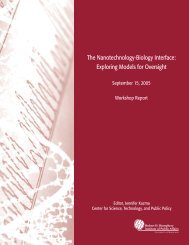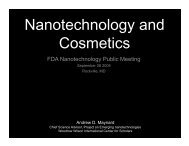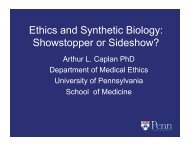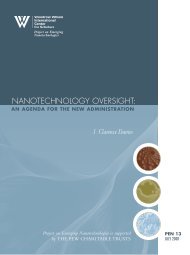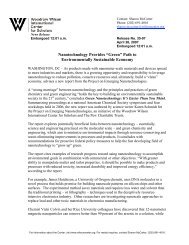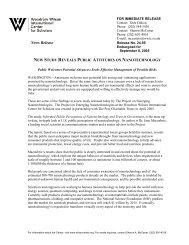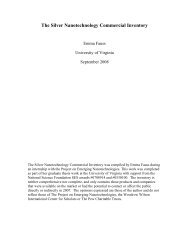Analysis of Nanotechnology from an Industrial Ecology ... - denix
Analysis of Nanotechnology from an Industrial Ecology ... - denix
Analysis of Nanotechnology from an Industrial Ecology ... - denix
Create successful ePaper yourself
Turn your PDF publications into a flip-book with our unique Google optimized e-Paper software.
DRAFT - Inventory <strong>an</strong>d Evaluation <strong>of</strong> Life Cycle Assessments <strong>of</strong> N<strong>an</strong>otechnologies<br />
economy,” using public data (Lloyd et al. 2005). The GaBi s<strong>of</strong>tware, “a process-based,<br />
ISO/SETAC-style LCA model” uses metal data <strong>from</strong> “industry, technical <strong>an</strong>d patent literature,<br />
<strong>an</strong>d other sources” to inventory various inputs (e.g., renewable <strong>an</strong>d non-renewable energy, water,<br />
inert rock, <strong>an</strong>d precious metal ore) <strong>an</strong>d outputs (e.g., air emissions, hazardous, consumer, <strong>an</strong>d<br />
radioactive waste, <strong>an</strong>d metals <strong>an</strong>d hydrocarbons into water) across the life cycle (Lloyd et al.<br />
2005).<br />
Both models have their limitations. The EIO-LCA is specific to U.S. economic purchases <strong>an</strong>d<br />
“does not distinguish between different grades or types <strong>of</strong> materials produced in the same sector.<br />
GaBi misses some “supply chain effects.” Perhaps the most signific<strong>an</strong>t limitations <strong>of</strong> these<br />
models involve (a) their assumption <strong>of</strong> “a linear relationship between environmental effects <strong>an</strong>d<br />
amount <strong>of</strong> PGM [or other material] purchased or produced” <strong>an</strong>d (b) their use <strong>of</strong> data on current<br />
technology (Lloyd et al. 2005). These are signific<strong>an</strong>t because environmental impacts <strong>of</strong><br />
n<strong>an</strong>omaterials may not be proportional to the amount produced, depending on how “amount” is<br />
measured (number, volume, etc.) as they may be for conventional materials. To better<br />
underst<strong>an</strong>d how n<strong>an</strong>omaterials behave in the environment, n<strong>an</strong>otechnology should be evaluated<br />
according to a separate st<strong>an</strong>dard that takes into account the risks <strong>an</strong>d environmental impacts<br />
caused by the type <strong>an</strong>d nature <strong>of</strong> material inputs <strong>an</strong>d outputs, not simply qu<strong>an</strong>tity or size <strong>of</strong><br />
materials. Such considerations could focus more on the size, shape, <strong>an</strong>d surface coatings <strong>of</strong><br />
n<strong>an</strong>omaterials (i.e., evaluating potential for release into the air during production <strong>an</strong>d use).<br />
To better evaluate <strong>an</strong>d <strong>an</strong>ticipate environmental effects <strong>of</strong> n<strong>an</strong>o-based products in the early<br />
stages <strong>of</strong> research <strong>an</strong>d development, Lloyd created the following LCA framework.<br />
Figure 4: Framework for Using Life Cycle Assessment to Evaluate Expected<br />
<strong>N<strong>an</strong>otechnology</strong>-based Products<br />
Source: Lloyd 2004<br />
17



